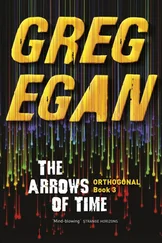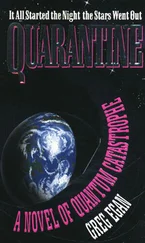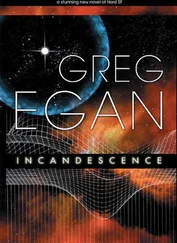Greg Egan - The Clockwork Rocket
Здесь есть возможность читать онлайн «Greg Egan - The Clockwork Rocket» весь текст электронной книги совершенно бесплатно (целиком полную версию без сокращений). В некоторых случаях можно слушать аудио, скачать через торрент в формате fb2 и присутствует краткое содержание. Жанр: Фантастика и фэнтези, на английском языке. Описание произведения, (предисловие) а так же отзывы посетителей доступны на портале библиотеки ЛибКат.
- Название:The Clockwork Rocket
- Автор:
- Жанр:
- Год:неизвестен
- ISBN:нет данных
- Рейтинг книги:3 / 5. Голосов: 1
-
Избранное:Добавить в избранное
- Отзывы:
-
Ваша оценка:
- 60
- 1
- 2
- 3
- 4
- 5
The Clockwork Rocket: краткое содержание, описание и аннотация
Предлагаем к чтению аннотацию, описание, краткое содержание или предисловие (зависит от того, что написал сам автор книги «The Clockwork Rocket»). Если вы не нашли необходимую информацию о книге — напишите в комментариях, мы постараемся отыскать её.
The Clockwork Rocket — читать онлайн бесплатно полную книгу (весь текст) целиком
Ниже представлен текст книги, разбитый по страницам. Система сохранения места последней прочитанной страницы, позволяет с удобством читать онлайн бесплатно книгу «The Clockwork Rocket», без необходимости каждый раз заново искать на чём Вы остановились. Поставьте закладку, и сможете в любой момент перейти на страницу, на которой закончили чтение.
Интервал:
Закладка:

As Yalda contemplated the picture, it struck her just how reminiscent it was of a beam of light and its accompanying wavefronts, shown at a single moment in time. The main difference was the annoying tilt between the wavefronts and the “beam”—here, a line showing the history of the pulse.
But what did that skewed angle actually signify? By changing to different units of measurement, she could stretch or squeeze the diagram as much as she liked. Nature had no idea what a pause or a flicker was; nothing real could depend on adhering to that traditional system of units. So she chose units of time that forced the pulse and the wavefronts to trace out lines at right angles to each other.

Where did that leave her? She had a right angle between some lines… and a linear relationship between two quantities squared.
She played around with the diagram for a couple of chimes, changing the units for distance as well as those for time in such a way that the separation between the wavefronts was simply declared equal to one. Well, why not? It wasn’t just time whose units were completely artificial; a scant had once been defined as the resting width of some self-important monarch’s thumb.
When she was done, a small right triangle sat inside a larger one in the same proportions. The hypotenuse of the larger triangle was a horizontal line that joined one wavefront to another, making its length simply equal to the wavelength of the light. The small triangle’s sides—corresponding to a distance the pulse traveled and a time in which it did so—had a ratio of lengths equal to the light’s velocity. The larger triangle shared that ratio, in such a manner that the length of one of its sides was the inverse velocity.
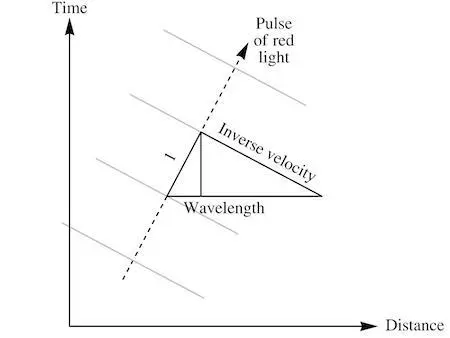
In her chosen units, then: the inverse velocity squared, plus one squared, was equal to the wavelength squared. That simple equation corresponded to the straight line that passed through the data she’d plotted. But now this relationship didn’t need to emerge from any hypothetical properties of the hypothetical medium whose vibrations manifested as light. The sum of the squares of the sides of a right triangle equaled the square of the hypotenuse. That was it: the entire wavelength-velocity relationship that she’d extracted from all those nights of painstaking observations had turned out to be nothing but a theorem from elementary geometry in disguise.
Except… that was nonsense. Geometry was concerned with figures in space, not lines that stretched across time as well. However suggestive these results were of geometry, that could only be an analogy, at best.
Albeit a mathematically perfect one. If she pretended that she really was doing geometry in a plane, she could simply rotate the whole physical structure of the red pulse—rigidly preserving the spacing of the wavefronts—and transform it into a faster, violet pulse.

The wavelength and velocity changed, of course, but those things were just measurements that depended on the way the stack of wavefronts was disposed, relative to the person doing the measuring. The two pulses, red and violet, were no more different in essence than a pulse of light traveling north and another traveling north-east.
The message from the stars was: light is light, always the same on its own terms. Qualities such as color , direction and speed were only meaningful distinctions once the light bumped into something else, against which it could be measured. In the void, it was simply light .
Yalda was feeling disoriented; she walked in a daze to the living quarters and lay down in the bed’s slippery white sand. None of her conclusions made sense; this was just heat shock talking. If she could hallucinate Thero for a whole night, she could lose her powers of reasoning for a day. She’d sleep off her sickness, and everything would be clear in the morning.
Yalda spent the next day re-checking her calculations. All the numbers she’d relied on were correct—and her geometrical constructions were so simple that a five-year-old could have confirmed that they were right.
The only thing she could still doubt was her interpretation. Her right triangle with its wavelength-long hypotenuse might actually be nothing but a useful mnemonic, an easy way of remembering the velocity-wavelength formula. Mathematics that echoed the rules of geometry could arise anywhere, with all the lines and angles that it implied really nothing more than abstractions.
So… light was a vibration in some exotic medium that just happened to possess qualities that perfectly mimicked all the would-be geometry she’d found in the equations? As well as contriving to support shear waves and pressure waves that traveled at exactly the same speed? Was there nothing this magical material couldn’t do?
The three polarizations of light traveled at the same speed, as if they were all the same kind of thing. Yalda brought one of her diagrams of pulses and wavefronts back onto her chest. The picture projected the three dimensions of space down to just one, but in reality each wavefront was a plane, and it traced out a three-dimensional set over time. Within that set there would be three independent directions that were orthogonal to the path of the light pulse through the four dimensions that included time. The three polarizations could all be transverse waves—waves that pointed sideways, in that four-dimensional sense. There’d be no need for a miraculous coincidence to make all their velocities the same.
It was almost dusk. Yalda walked out of the building and sat at the top of the access path. Either she had lost her mind, or she had stumbled upon something that needed to be pursued much further.
She tinkered with the wavefront diagram on her chest. She’d been wondering about the significance of the inner triangle, the triangle whose hypotenuse was one. The ratio of its sides was the light’s velocity, but what exactly did the individual side lengths represent?
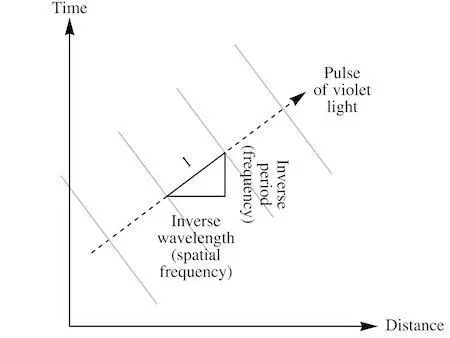
A simple argument with proportions established their values—which yielded a new triangular relationship, more elegant and symmetrical than the first: the sum of the squares of light’s frequencies in time and in space would equal one . Well, only her special choice of units set the sum equal to one , but the fact remained that the equivalent in cycles per scant or stride or saunter would still be independent of the color of the light.
That was really no different from saying that the true distance between furrows ploughed by a given plow did not depend on whether someone happened to walk across them askew. The wavefronts of light were all furrows from the same plow; the light’s speed, color, wavelength and frequency simply measured the angle at which you crossed the furrows.
But if light was going to play by these geometric rules, then everything it touched—every system that created or absorbed light, every substance that bent, scattered or distorted it—would have to function the same way. Ultimately, to keep the world consistent, any kind of physics that took place at one angle would have to work just as well if you picked it up and rotated it in four dimensions.
Читать дальшеИнтервал:
Закладка:
Похожие книги на «The Clockwork Rocket»
Представляем Вашему вниманию похожие книги на «The Clockwork Rocket» списком для выбора. Мы отобрали схожую по названию и смыслу литературу в надежде предоставить читателям больше вариантов отыскать новые, интересные, ещё непрочитанные произведения.
Обсуждение, отзывы о книге «The Clockwork Rocket» и просто собственные мнения читателей. Оставьте ваши комментарии, напишите, что Вы думаете о произведении, его смысле или главных героях. Укажите что конкретно понравилось, а что нет, и почему Вы так считаете.



